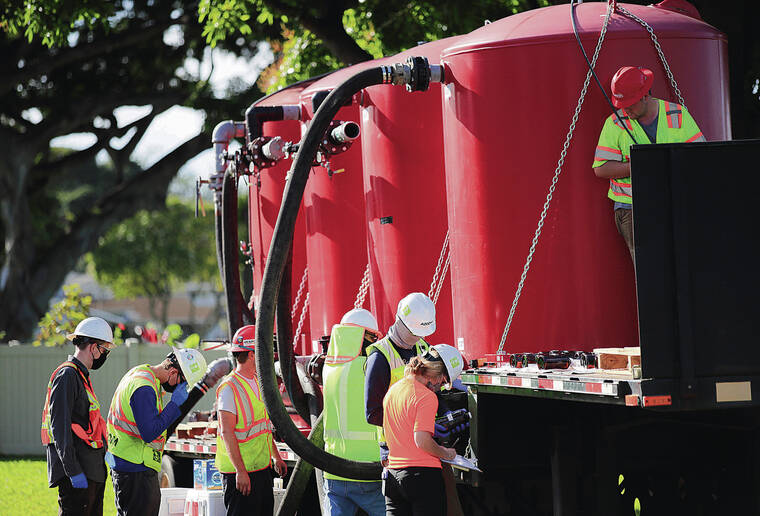Imminent peril.
Ultimately the decision on whether the state Department of Health’s emergency order on the Navy’s Red Hill underground fuel storage tanks will be carried out may hinge on the legal understanding of that term.
The Navy has contested that order, which triggered the contested case hearing that, on Monday and Tuesday, put the evidence from both sides on public display online.
In the course of laying out just how much it’s invested to correct the current contamination of water largely serving nearby housing areas, the Navy actually made the case for those who want the fuel removed from tanks just above Oahu’s main aquifer.
The reason is clear: There is peril.
If it’s already been so costly to flush the contaminated Red Hill well, filter the water and accommodate the affected families, any future leak that threatens the majority of Oahu residents will require even more substantial corrective actions. The state and county agencies that oversee the safety of the water supply simply can’t accept that level of risk.
It’s no longer a theoretical risk. There was a leak of up to 19,000 gallons on May 6, and the Navy officials now believe that this was the origin of what by late November found its way into the drinking water of about 93,000 people in neighborhoods in and around Joint Base Pearl Harbor-Hickam.
But this is still being described officially by the military as a “working theory,” so there can be no confidence that, after all this time, the Navy knows precisely how such accidents happen or how to control them when they do.
The state’s emergency order calls for the Navy to drain its Red Hill fuel tanks, clean the contamination and address safety issues at the facility before seeking state permission to restart operations. In closing remarks Tuesday in the two-day evidentiary hearing on the orders, the Navy argued that it has addressed the contamination. Because it has done so, said Craig Jensen, an attorney representing the Navy, there is no longer the “imminent peril” and no justification for the DOH emergency order that is also favored by the Board of Water Supply and the Sierra Club of Hawaii.
“They’re focused on the what-ifs,” Jensen said, referring to the local agencies. “On the other hand you have the Department of the Navy, and we’re focused on what happened.
“An emergency order must focus on what’s happening now or just about to happen, what is the imminent peril and how to handle it.”
Lawyers advocating for the order dispute that interpretation of what can constitute a peril, under the law. And, said Ella Foley Gannon, the attorney representing the water board, the public learned about it not from any Navy detection system, but from smelling it and tasting it in their own water.
She is right. Regardless of what the Navy has spent on the problem now, there is the very real potential for recurrence — a spill that could foul the water supply of some 400,000 people.
The Pentagon’s Inspector General’s Office has responded to the Hawaii congressional delegation’s call for an investigation, and the public can draw some hope from that. The inquiry aims to evaluate the Navy’s management of the “operation, maintenance, safety and oversight” of the Red Hill facility, protecting the environment and drinking water.
Independent oversight will be crucial in determining next steps. The Navy surely will argue that fueling the fleet is a core duty for its Hawaii operations in maintaining national security in the Pacific, and that’s true.
But could fuel storage be moved above ground, away from the aquifer? In 2018 the Navy awarded a contract to replace its 40 World War II vintage underground tanks with six above-ground tanks at Naval Base Kitsap in Washington state.
So the answer seems to be “yes” — fuel storage can be relocated. Protecting public health is part of national security, too.

